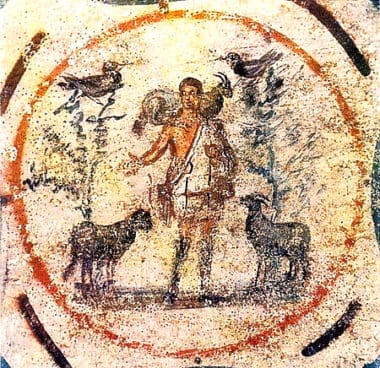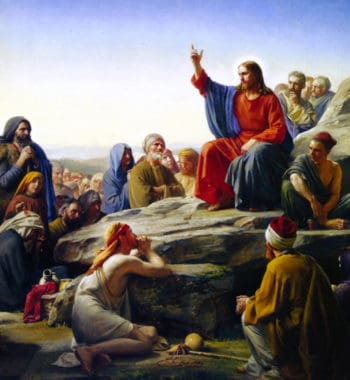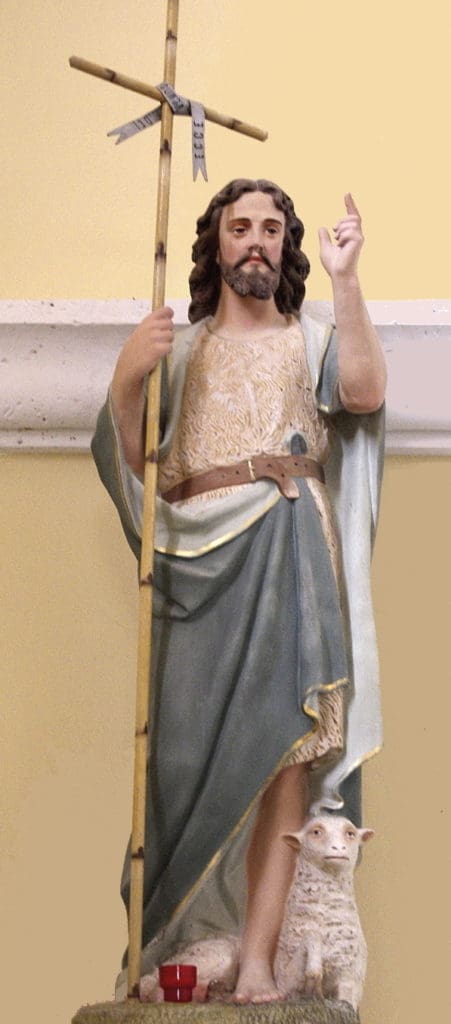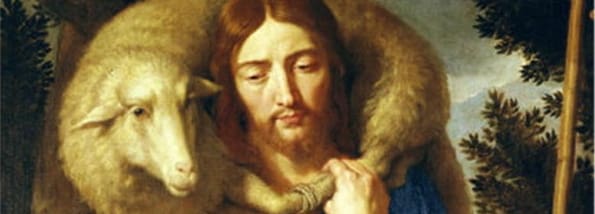Christ, the Good Shepherd
Mysticism and Magisterium Part IV
In the Church of the first four centuries, the most common artistic representation of Christ was that of the Good Shepherd. By reflecting on the historical significance of this image we might come to a better understanding of the pastoral authority of the Church.
 Found especially in the catacombs of Rome, the Good Shepherd was not a portrait of Jesus but a symbol in which Christ was presented in the form of a Roman boy with a lamb around his neck. But this is really only half the story because what the image actually represents is the Lukan version of the parable of the lost sheep (15:4-7), whereas Our Lord refers to himself as the “Good Shepherd” within the gospel of John (10:11-16) in a somewhat different context.
Found especially in the catacombs of Rome, the Good Shepherd was not a portrait of Jesus but a symbol in which Christ was presented in the form of a Roman boy with a lamb around his neck. But this is really only half the story because what the image actually represents is the Lukan version of the parable of the lost sheep (15:4-7), whereas Our Lord refers to himself as the “Good Shepherd” within the gospel of John (10:11-16) in a somewhat different context.
Certainly that shepherd is good, who leaves the ninety-nine in the wilderness in order to find the one lost sheep. Our Lord told this parable in order to silence the Pharisees who  were scandalized that He ate with sinners. Today it is much the same: Pope Francis is a scandal to many because he is slow to condemn sinners, though he does not fail to condemn sin.
were scandalized that He ate with sinners. Today it is much the same: Pope Francis is a scandal to many because he is slow to condemn sinners, though he does not fail to condemn sin.
But the image that more aptly corresponds to Our Lord’s words about the Good Shepherd is not as idyllic. I am the good shepherd. The good shepherd lays down his life for the sheep (Jn 10:11). To my knowledge, this more explicit version of the Good Shepherd has ever been the subject of sacred art. Here an older, more robust shepherd stands with staff gripped firmly with both hands like a sword, his feet planted between his flock behind him and the pack of wolves advancing towards him.
Many dogs have surrounded me, a band of the wicked beset me. They tear holes in my hands and my feet and lay me in the dust of death (Ps 22:16-17).
For whatever reason, by the fifth century these images disappeared and were replaced by images of Christ as Teacher and King and did not reappear until the Middle Ages.  Incidentally, more or less at the same time the image of the Good Shepherd disappeared, the first crucifixes arrived on the scene, which never showed Christ in death, but alive, standing upright and majestic.
Incidentally, more or less at the same time the image of the Good Shepherd disappeared, the first crucifixes arrived on the scene, which never showed Christ in death, but alive, standing upright and majestic.
These scriptural and cultural images of the Good Shepherd, and all they imply, reflect what I have asserted in previous posts, namely, that Christ, the One Teacher of All, is present in the details of ecclesiastical history.
Sometimes we are tempted to think the crisis of our times is wholly unique, when in fact the Church has always been under threat and in need of reform. Even in the glorious period of the 13th century, which gave us Saints Francis and Dominic and the Holy Doctors Bonaventure and Thomas, the orders to which they belonged arose in response to widespread infidelity among bishops, priests and religious. Not only did the Franciscans and Dominicans separate themselves from ecclesiastical worldliness, but they also had to distinguish themselves from most evangelical reform movements, such as the Cathars, Joachimites and Waldensians.
The Church is constantly beset by enemies from within and without. For this reason, history itself must be interpreted in the mystery of Christ and His cross.
The pastoral authority of the Church is often misunderstood today as having little or nothing to do with doctrine, and as more or less synonymous with “mercy without doctrine.” But in reality, the pastoral authority of the magisterium has to do with the shepherding of the Church through the uncertainties of history, which are both a matter of doctrine and the discernment of the signs of the times. For instance, the foundation of the Franciscan and Dominican Orders was of this kind: it involved a doctrine, namely, that the charisms of Francis and Dominic were not contrary to the teaching of the Church, but it also established a new kind of religious life aimed at renewing the Church’s missionary dynamism. This was an experiment that had no earthly guarantees.
In fact, within only a few decades of the death of St. Francis, the Franciscan Order was pitted against itself, with a large portion of its members adhering to the heresy of Joachim, and many others succumbing to worldliness. Without the intervention of divine providence, the whole Order may have ceased to exist within the first century of its foundation. Thus, also the Church throughout the ages.
We would all do well to remember that it is not just Christ the Teacher who is often opposed in history, but also Christ the Pastor. It was not the image of the Teacher, nor that of the quaint boy shepherd that the Twelve struggled with, but the Pastor who was leading them to Jerusalem where he was to suffer and die at the teeth of wolves. And Peter took him and began to rebuke him, saying, “God forbid, Lord! This shall never happen to you.” (Mt 16:22)
The Good Shepherd appeared to St. Francis from the crucifix of San Damiano, a Byzantine work already ancient at that time, in the style of those first images of the crucified King. He said: “rebuild my Church for it is being destroyed.” St. Francis did precisely that, through an evangelical form of life, whose Catholicity was guaranteed by unqualified obedience to the Church. At the end of his life, the wounds of Christ were impressed into his body as into hot wax, as a seal and sign that his form of life was truly a remedy to the uncertainties of the times.
 In the order of divine providence, the name of our present Pope reminds us that, in times of crisis, Christ remains with His Church. Pope Francis has asked for our prayers, and for our constructive advice and criticism (Evangelii Gaudium, paragraph 32), but we should not allow our concerns to shake our trust in divine providence and lead us to a spirit of schism. Loyalty stands between the extremes of optimism and pessimism.
In the order of divine providence, the name of our present Pope reminds us that, in times of crisis, Christ remains with His Church. Pope Francis has asked for our prayers, and for our constructive advice and criticism (Evangelii Gaudium, paragraph 32), but we should not allow our concerns to shake our trust in divine providence and lead us to a spirit of schism. Loyalty stands between the extremes of optimism and pessimism.
Such trust in the Church is not a trust in man, but in God. We should pray for our leaders to be good shepherds, after the heart of Christ (cf., Jer 3:15), but we should also remember that we will never be abandoned by the Divine Good Shepherd, no matter what we are tempted to think of the men who lead us.
History is more than the sum of its parts because of the mystery of divine providence. Our Shepherd guides and defends us by the staff of the Cross.
Editor’s Note: A listing of all the posts in the “Mysticism and Magisterium” Series can be found here.
+
Art for this post on the Good Shepherd: Christ, the Good Shepherd, Catacomb of Priscilla, Rome, Italy, Second half of 3rd century, unknown painter, PD-US copyright expired; The Good Shepherd, unknown painter – probably Mihály Mankovics, late 18th century, Greek Catholic Cathedral of Hajdúdorog, Hungary, CCA-SA; Mirror of Intérieur de l’église de Piégut – Jésus avec mouton (Inside the Church of Piégut – Jesus with Sheep), unknown artist, photography by Traumrune, 01/07/12, CCA-SA; Wikimedia Commons. The Sermon on the Mount, Carl Heinrich Bloch, 1877, Restored Traditions, used with permission. Feature Image: Le Bon Pasteur (The Good Shepherd), Jean Baptiste de Champaigne, 17th century, PD-US, Wikimedia Commons.


